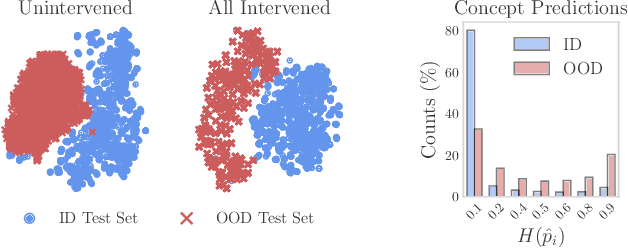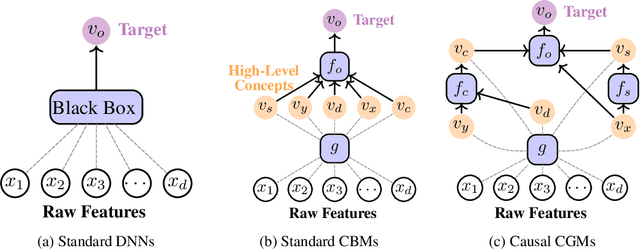Pietro Barbiero
Università della Svizzera Italiana and University of Cambridge
If Concept Bottlenecks are the Question, are Foundation Models the Answer?
Apr 29, 2025Abstract:Concept Bottleneck Models (CBMs) are neural networks designed to conjoin high performance with ante-hoc interpretability. CBMs work by first mapping inputs (e.g., images) to high-level concepts (e.g., visible objects and their properties) and then use these to solve a downstream task (e.g., tagging or scoring an image) in an interpretable manner. Their performance and interpretability, however, hinge on the quality of the concepts they learn. The go-to strategy for ensuring good quality concepts is to leverage expert annotations, which are expensive to collect and seldom available in applications. Researchers have recently addressed this issue by introducing "VLM-CBM" architectures that replace manual annotations with weak supervision from foundation models. It is however unclear what is the impact of doing so on the quality of the learned concepts. To answer this question, we put state-of-the-art VLM-CBMs to the test, analyzing their learned concepts empirically using a selection of significant metrics. Our results show that, depending on the task, VLM supervision can sensibly differ from expert annotations, and that concept accuracy and quality are not strongly correlated. Our code is available at https://github.com/debryu/CQA.
Avoiding Leakage Poisoning: Concept Interventions Under Distribution Shifts
Apr 24, 2025



Abstract:In this paper, we investigate how concept-based models (CMs) respond to out-of-distribution (OOD) inputs. CMs are interpretable neural architectures that first predict a set of high-level concepts (e.g., stripes, black) and then predict a task label from those concepts. In particular, we study the impact of concept interventions (i.e., operations where a human expert corrects a CM's mispredicted concepts at test time) on CMs' task predictions when inputs are OOD. Our analysis reveals a weakness in current state-of-the-art CMs, which we term leakage poisoning, that prevents them from properly improving their accuracy when intervened on for OOD inputs. To address this, we introduce MixCEM, a new CM that learns to dynamically exploit leaked information missing from its concepts only when this information is in-distribution. Our results across tasks with and without complete sets of concept annotations demonstrate that MixCEMs outperform strong baselines by significantly improving their accuracy for both in-distribution and OOD samples in the presence and absence of concept interventions.
Deferring Concept Bottleneck Models: Learning to Defer Interventions to Inaccurate Experts
Mar 20, 2025Abstract:Concept Bottleneck Models (CBMs) are machine learning models that improve interpretability by grounding their predictions on human-understandable concepts, allowing for targeted interventions in their decision-making process. However, when intervened on, CBMs assume the availability of humans that can identify the need to intervene and always provide correct interventions. Both assumptions are unrealistic and impractical, considering labor costs and human error-proneness. In contrast, Learning to Defer (L2D) extends supervised learning by allowing machine learning models to identify cases where a human is more likely to be correct than the model, thus leading to deferring systems with improved performance. In this work, we gain inspiration from L2D and propose Deferring CBMs (DCBMs), a novel framework that allows CBMs to learn when an intervention is needed. To this end, we model DCBMs as a composition of deferring systems and derive a consistent L2D loss to train them. Moreover, by relying on a CBM architecture, DCBMs can explain why defer occurs on the final task. Our results show that DCBMs achieve high predictive performance and interpretability at the cost of deferring more to humans.
Logic Explanation of AI Classifiers by Categorical Explaining Functors
Mar 20, 2025Abstract:The most common methods in explainable artificial intelligence are post-hoc techniques which identify the most relevant features used by pretrained opaque models. Some of the most advanced post hoc methods can generate explanations that account for the mutual interactions of input features in the form of logic rules. However, these methods frequently fail to guarantee the consistency of the extracted explanations with the model's underlying reasoning. To bridge this gap, we propose a theoretically grounded approach to ensure coherence and fidelity of the extracted explanations, moving beyond the limitations of current heuristic-based approaches. To this end, drawing from category theory, we introduce an explaining functor which structurally preserves logical entailment between the explanation and the opaque model's reasoning. As a proof of concept, we validate the proposed theoretical constructions on a synthetic benchmark verifying how the proposed approach significantly mitigates the generation of contradictory or unfaithful explanations.
Causally Reliable Concept Bottleneck Models
Mar 06, 2025Abstract:Concept-based models are an emerging paradigm in deep learning that constrains the inference process to operate through human-interpretable concepts, facilitating explainability and human interaction. However, these architectures, on par with popular opaque neural models, fail to account for the true causal mechanisms underlying the target phenomena represented in the data. This hampers their ability to support causal reasoning tasks, limits out-of-distribution generalization, and hinders the implementation of fairness constraints. To overcome these issues, we propose \emph{Causally reliable Concept Bottleneck Models} (C$^2$BMs), a class of concept-based architectures that enforce reasoning through a bottleneck of concepts structured according to a model of the real-world causal mechanisms. We also introduce a pipeline to automatically learn this structure from observational data and \emph{unstructured} background knowledge (e.g., scientific literature). Experimental evidence suggest that C$^2$BM are more interpretable, causally reliable, and improve responsiveness to interventions w.r.t. standard opaque and concept-based models, while maintaining their accuracy.
Neural Interpretable Reasoning
Feb 17, 2025

Abstract:We formalize a novel modeling framework for achieving interpretability in deep learning, anchored in the principle of inference equivariance. While the direct verification of interpretability scales exponentially with the number of variables of the system, we show that this complexity can be mitigated by treating interpretability as a Markovian property and employing neural re-parametrization techniques. Building on these insights, we propose a new modeling paradigm -- neural generation and interpretable execution -- that enables scalable verification of equivariance. This paradigm provides a general approach for designing Neural Interpretable Reasoners that are not only expressive but also transparent.
A Survey on Federated Learning in Human Sensing
Jan 07, 2025Abstract:Human Sensing, a field that leverages technology to monitor human activities, psycho-physiological states, and interactions with the environment, enhances our understanding of human behavior and drives the development of advanced services that improve overall quality of life. However, its reliance on detailed and often privacy-sensitive data as the basis for its machine learning (ML) models raises significant legal and ethical concerns. The recently proposed ML approach of Federated Learning (FL) promises to alleviate many of these concerns, as it is able to create accurate ML models without sending raw user data to a central server. While FL has demonstrated its usefulness across a variety of areas, such as text prediction and cyber security, its benefits in Human Sensing are under-explored, given the particular challenges in this domain. This survey conducts a comprehensive analysis of the current state-of-the-art studies on FL in Human Sensing, and proposes a taxonomy and an eight-dimensional assessment for FL approaches. Through the eight-dimensional assessment, we then evaluate whether the surveyed studies consider a specific FL-in-Human-Sensing challenge or not. Finally, based on the overall analysis, we discuss open challenges and highlight five research aspects related to FL in Human Sensing that require urgent research attention. Our work provides a comprehensive corpus of FL studies and aims to assist FL practitioners in developing and evaluating solutions that effectively address the real-world complexities of Human Sensing.
Interpretable Concept-Based Memory Reasoning
Jul 22, 2024



Abstract:The lack of transparency in the decision-making processes of deep learning systems presents a significant challenge in modern artificial intelligence (AI), as it impairs users' ability to rely on and verify these systems. To address this challenge, Concept Bottleneck Models (CBMs) have made significant progress by incorporating human-interpretable concepts into deep learning architectures. This approach allows predictions to be traced back to specific concept patterns that users can understand and potentially intervene on. However, existing CBMs' task predictors are not fully interpretable, preventing a thorough analysis and any form of formal verification of their decision-making process prior to deployment, thereby raising significant reliability concerns. To bridge this gap, we introduce Concept-based Memory Reasoner (CMR), a novel CBM designed to provide a human-understandable and provably-verifiable task prediction process. Our approach is to model each task prediction as a neural selection mechanism over a memory of learnable logic rules, followed by a symbolic evaluation of the selected rule. The presence of an explicit memory and the symbolic evaluation allow domain experts to inspect and formally verify the validity of certain global properties of interest for the task prediction process. Experimental results demonstrate that CMR achieves comparable accuracy-interpretability trade-offs to state-of-the-art CBMs, discovers logic rules consistent with ground truths, allows for rule interventions, and allows pre-deployment verification.
Self-supervised Interpretable Concept-based Models for Text Classification
Jun 20, 2024



Abstract:Despite their success, Large-Language Models (LLMs) still face criticism as their lack of interpretability limits their controllability and reliability. Traditional post-hoc interpretation methods, based on attention and gradient-based analysis, offer limited insight into the model's decision-making processes. In the image field, Concept-based models have emerged as explainable-by-design architectures, employing human-interpretable features as intermediate representations. However, these methods have not been yet adapted to textual data, mainly because they require expensive concept annotations, which are impractical for real-world text data. This paper addresses this challenge by proposing a self-supervised Interpretable Concept Embedding Models (ICEMs). We leverage the generalization abilities of LLMs to predict the concepts labels in a self-supervised way, while we deliver the final predictions with an interpretable function. The results of our experiments show that ICEMs can be trained in a self-supervised way achieving similar performance to fully supervised concept-based models and end-to-end black-box ones. Additionally, we show that our models are (i) interpretable, offering meaningful logical explanations for their predictions; (ii) interactable, allowing humans to modify intermediate predictions through concept interventions; and (iii) controllable, guiding the LLMs' decoding process to follow a required decision-making path.
Causal Concept Embedding Models: Beyond Causal Opacity in Deep Learning
May 28, 2024



Abstract:Causal opacity denotes the difficulty in understanding the "hidden" causal structure underlying a deep neural network's (DNN) reasoning. This leads to the inability to rely on and verify state-of-the-art DNN-based systems especially in high-stakes scenarios. For this reason, causal opacity represents a key open challenge at the intersection of deep learning, interpretability, and causality. This work addresses this gap by introducing Causal Concept Embedding Models (Causal CEMs), a class of interpretable models whose decision-making process is causally transparent by design. The results of our experiments show that Causal CEMs can: (i) match the generalization performance of causally-opaque models, (ii) support the analysis of interventional and counterfactual scenarios, thereby improving the model's causal interpretability and supporting the effective verification of its reliability and fairness, and (iii) enable human-in-the-loop corrections to mispredicted intermediate reasoning steps, boosting not just downstream accuracy after corrections but also accuracy of the explanation provided for a specific instance.
 Add to Chrome
Add to Chrome Add to Firefox
Add to Firefox Add to Edge
Add to Edge